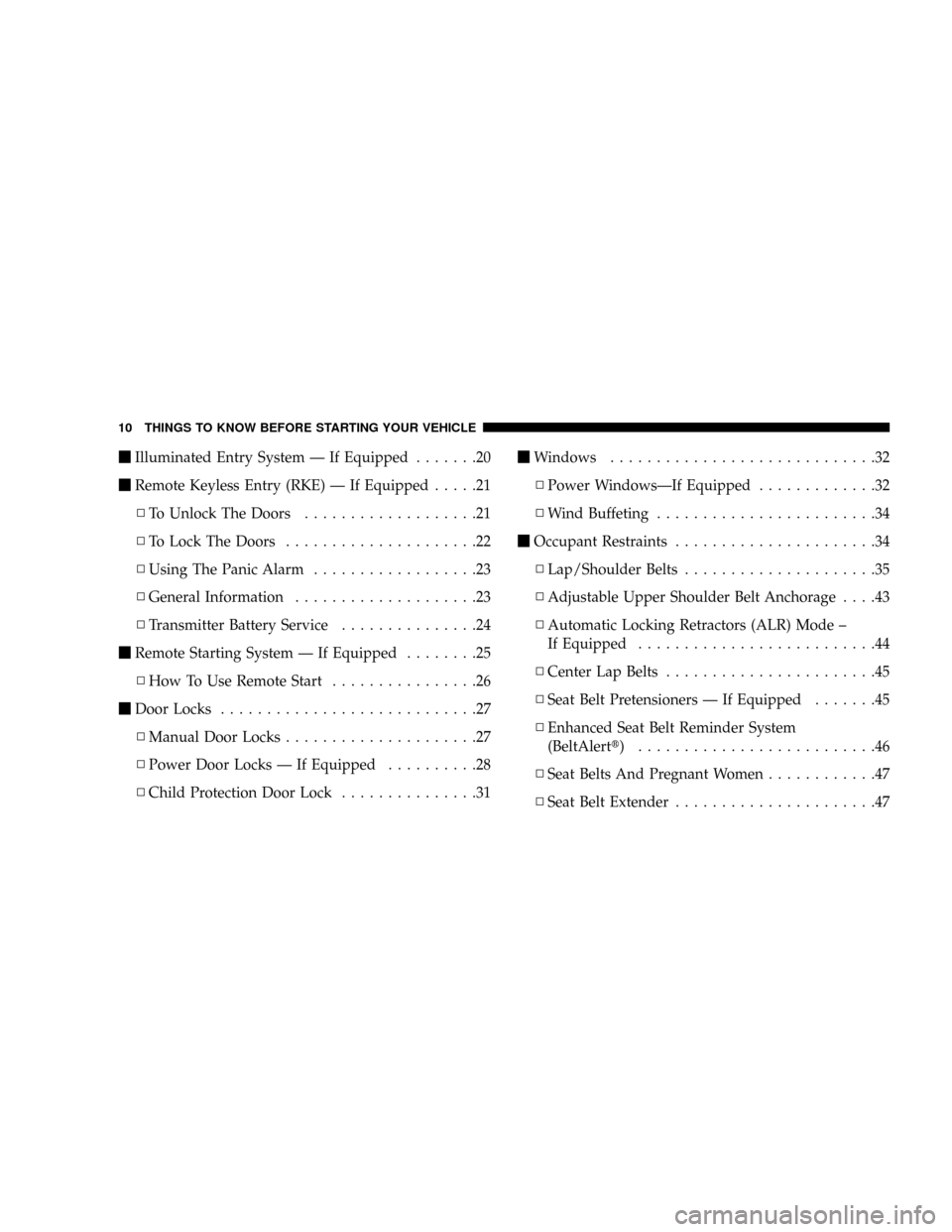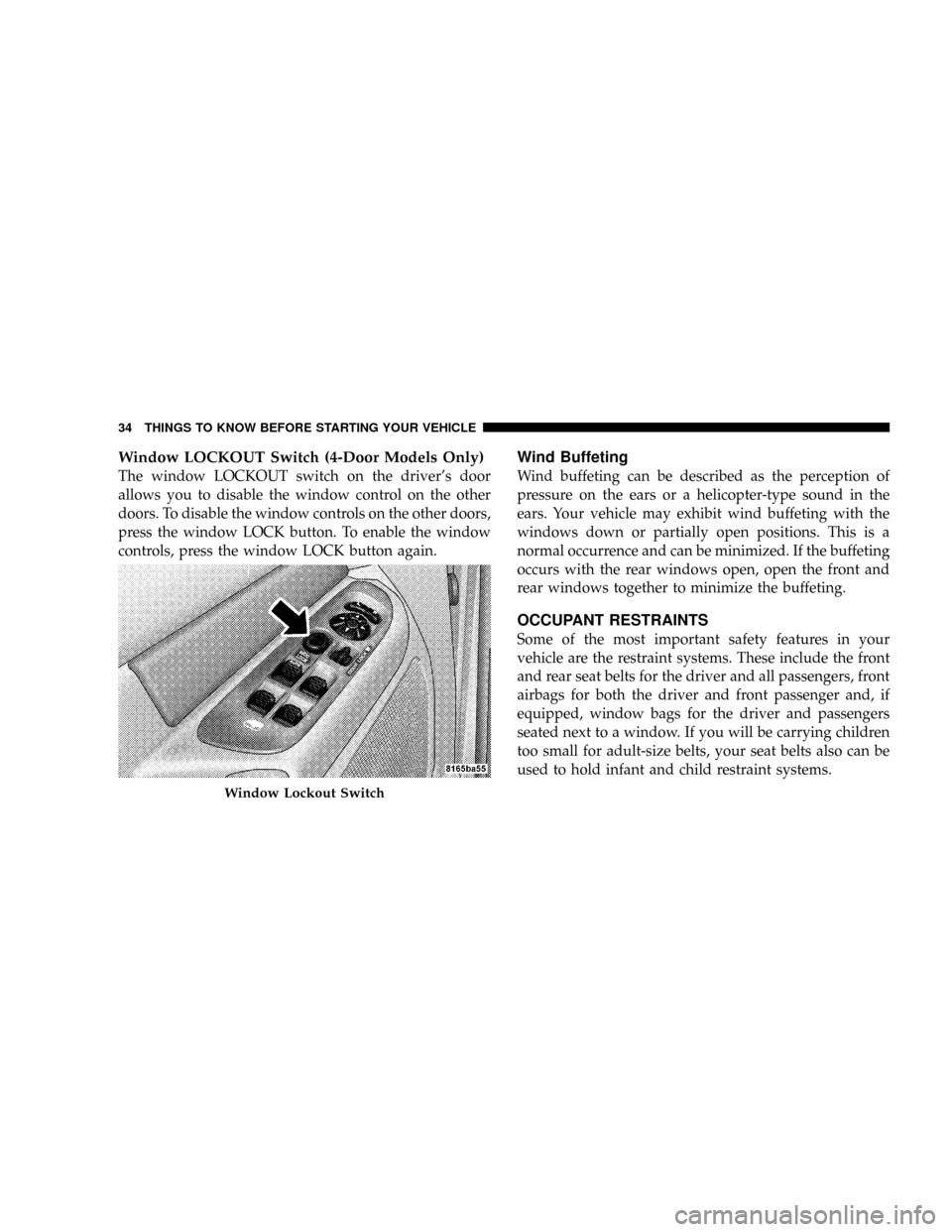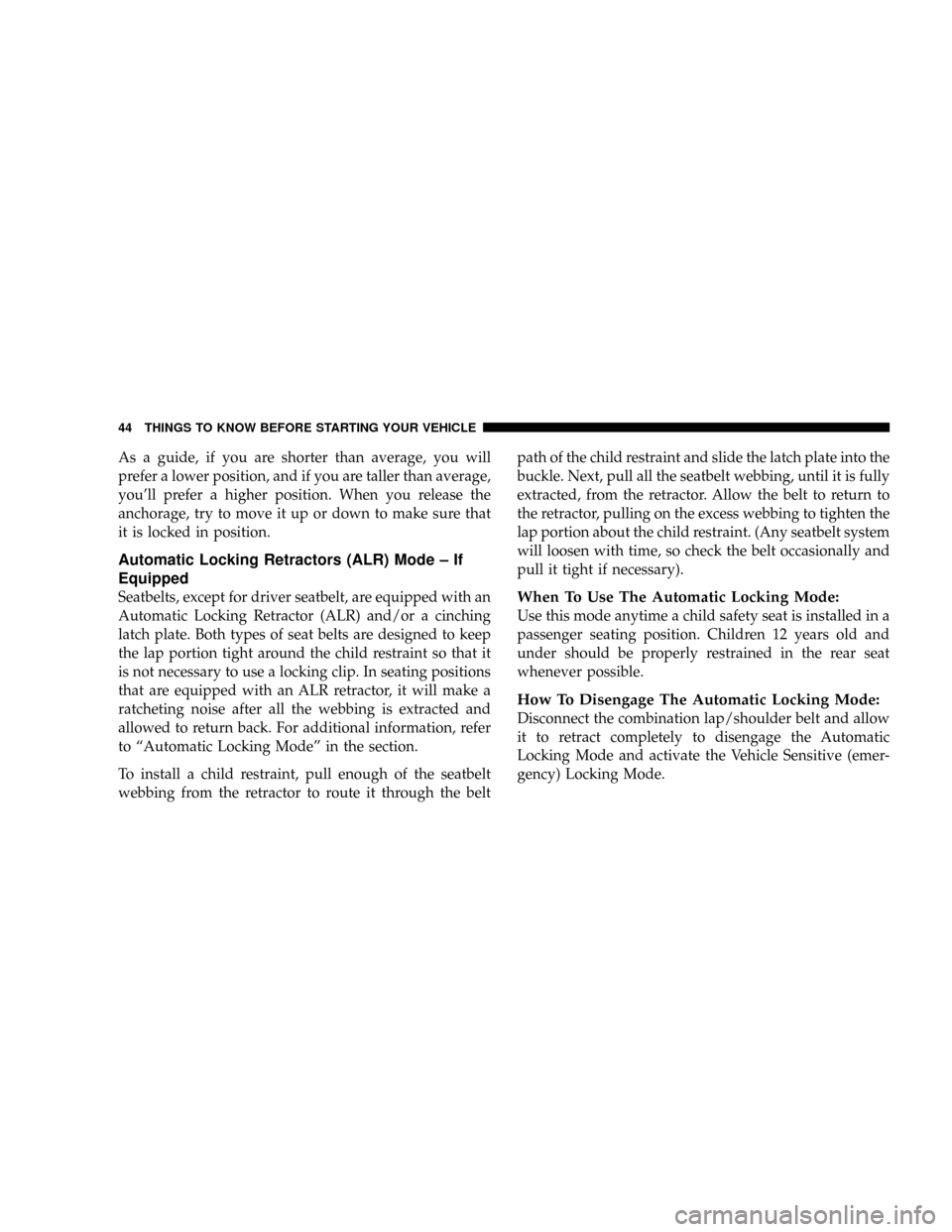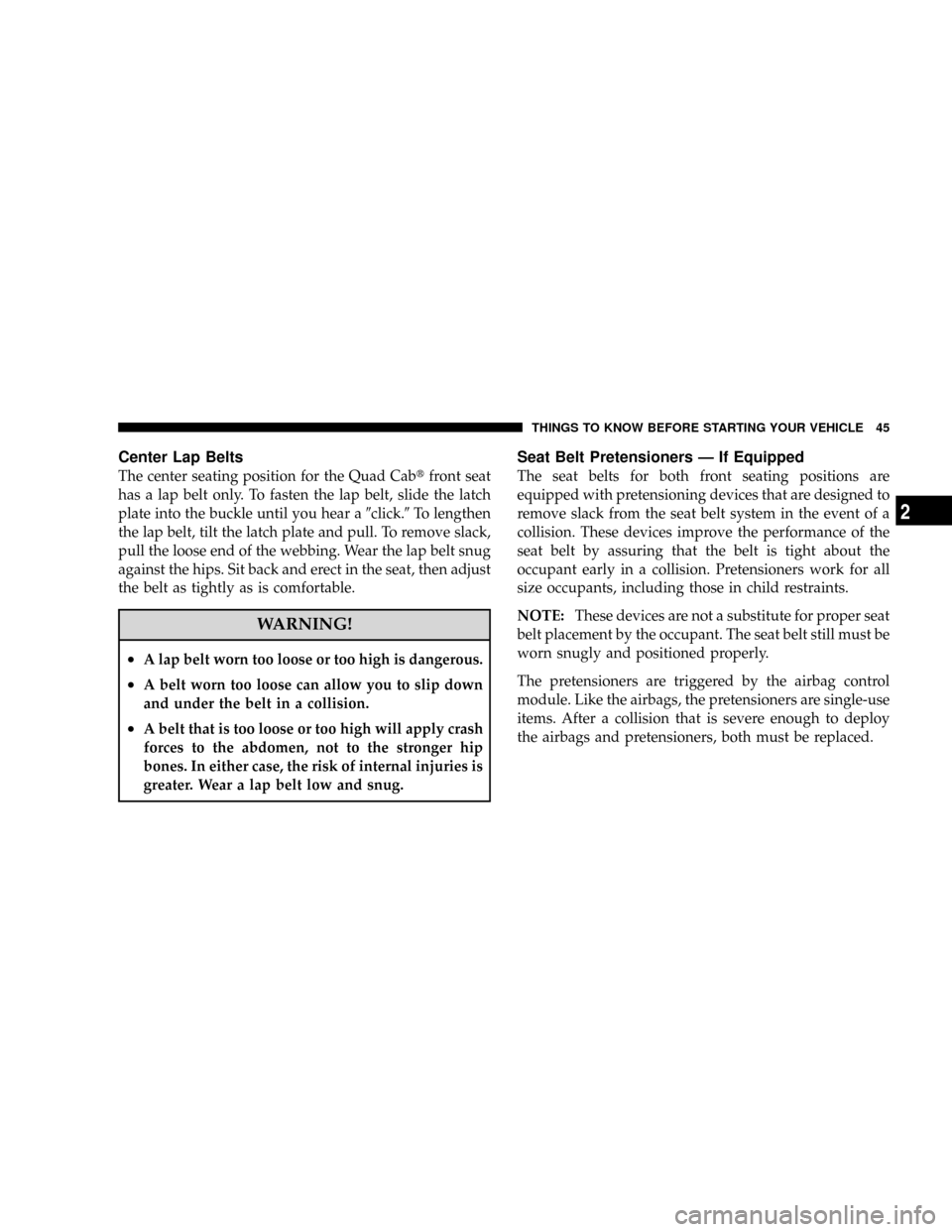Page 12 of 554

mIlluminated Entry System Ð If Equipped.......20
mRemote Keyless Entry (RKE) Ð If Equipped.....21
NTo Unlock The Doors...................21
NTo Lock The Doors.....................22
NUsing The Panic Alarm..................23
NGeneral Information....................23
NTransmitter Battery Service...............24
mRemote Starting System Ð If Equipped........25
NHow To Use Remote Start................26
mDoor Locks............................27
NManual Door Locks.....................27
NPower Door Locks Ð If Equipped..........28
NChild Protection Door Lock...............31mWindows.............................32
NPower WindowsÐIf Equipped.............32
NWind Buffeting........................34
mOccupant Restraints......................34
NLap/Shoulder Belts.....................35
NAdjustable Upper Shoulder Belt Anchorage....43
NAutomatic Locking Retractors (ALR) Mode ±
If Equipped..........................44
NCenter Lap Belts.......................45
NSeat Belt Pretensioners Ð If Equipped.......45
NEnhanced Seat Belt Reminder System
(BeltAlertt) ..........................46
NSeat Belts And Pregnant Women............47
NSeat Belt Extender......................47
10 THINGS TO KNOW BEFORE STARTING YOUR VEHICLE
Page 33 of 554
Child Protection Door Lock
To provide a safer environment for children riding in the
rear seat, the rear doors of your vehicle have the child
protection door lock system.To use the system, open each rear door, slide the lever UP
to engage the locks and DOWN to disengage the child
protection locks. When the system on a door is engaged,
that door can only be opened by using the outside door
handle even, if the inside door LOCK is in the UN-
LOCKED position.
Child Protection Door Lock Location
Child Lock Control
THINGS TO KNOW BEFORE STARTING YOUR VEHICLE 31
2
Page 36 of 554

Window LOCKOUT Switch (4-Door Models Only)
The window LOCKOUT switch on the driver's door
allows you to disable the window control on the other
doors. To disable the window controls on the other doors,
press the window LOCK button. To enable the window
controls, press the window LOCK button again.
Wind Buffeting
Wind buffeting can be described as the perception of
pressure on the ears or a helicopter-type sound in the
ears. Your vehicle may exhibit wind buffeting with the
windows down or partially open positions. This is a
normal occurrence and can be minimized. If the buffeting
occurs with the rear windows open, open the front and
rear windows together to minimize the buffeting.
OCCUPANT RESTRAINTS
Some of the most important safety features in your
vehicle are the restraint systems. These include the front
and rear seat belts for the driver and all passengers, front
airbags for both the driver and front passenger and, if
equipped, window bags for the driver and passengers
seated next to a window. If you will be carrying children
too small for adult-size belts, your seat belts also can be
used to hold infant and child restraint systems.
Window Lockout Switch
34 THINGS TO KNOW BEFORE STARTING YOUR VEHICLE
Page 46 of 554

As a guide, if you are shorter than average, you will
prefer a lower position, and if you are taller than average,
you'll prefer a higher position. When you release the
anchorage, try to move it up or down to make sure that
it is locked in position.
Automatic Locking Retractors (ALR) Mode ± If
Equipped
Seatbelts, except for driver seatbelt, are equipped with an
Automatic Locking Retractor (ALR) and/or a cinching
latch plate. Both types of seat belts are designed to keep
the lap portion tight around the child restraint so that it
is not necessary to use a locking clip. In seating positions
that are equipped with an ALR retractor, it will make a
ratcheting noise after all the webbing is extracted and
allowed to return back. For additional information, refer
to ªAutomatic Locking Modeº in the section.
To install a child restraint, pull enough of the seatbelt
webbing from the retractor to route it through the beltpath of the child restraint and slide the latch plate into the
buckle. Next, pull all the seatbelt webbing, until it is fully
extracted, from the retractor. Allow the belt to return to
the retractor, pulling on the excess webbing to tighten the
lap portion about the child restraint. (Any seatbelt system
will loosen with time, so check the belt occasionally and
pull it tight if necessary).When To Use The Automatic Locking Mode:
Use this mode anytime a child safety seat is installed in a
passenger seating position. Children 12 years old and
under should be properly restrained in the rear seat
whenever possible.
How To Disengage The Automatic Locking Mode:
Disconnect the combination lap/shoulder belt and allow
it to retract completely to disengage the Automatic
Locking Mode and activate the Vehicle Sensitive (emer-
gency) Locking Mode.
44 THINGS TO KNOW BEFORE STARTING YOUR VEHICLE
Page 47 of 554

Center Lap Belts
The center seating position for the Quad Cabtfront seat
has a lap belt only. To fasten the lap belt, slide the latch
plate into the buckle until you hear a9click.9To lengthen
the lap belt, tilt the latch plate and pull. To remove slack,
pull the loose end of the webbing. Wear the lap belt snug
against the hips. Sit back and erect in the seat, then adjust
the belt as tightly as is comfortable.
WARNING!
²A lap belt worn too loose or too high is dangerous.
²A belt worn too loose can allow you to slip down
and under the belt in a collision.
²A belt that is too loose or too high will apply crash
forces to the abdomen, not to the stronger hip
bones. In either case, the risk of internal injuries is
greater. Wear a lap belt low and snug.
Seat Belt Pretensioners Ð If Equipped
The seat belts for both front seating positions are
equipped with pretensioning devices that are designed to
remove slack from the seat belt system in the event of a
collision. These devices improve the performance of the
seat belt by assuring that the belt is tight about the
occupant early in a collision. Pretensioners work for all
size occupants, including those in child restraints.
NOTE:These devices are not a substitute for proper seat
belt placement by the occupant. The seat belt still must be
worn snugly and positioned properly.
The pretensioners are triggered by the airbag control
module. Like the airbags, the pretensioners are single-use
items. After a collision that is severe enough to deploy
the airbags and pretensioners, both must be replaced.
THINGS TO KNOW BEFORE STARTING YOUR VEHICLE 45
2
Page 52 of 554

Here are some simple steps you can follow to minimize
the risk of harm from a deploying airbag.
1. Children 12 years and under should always ride
buckled up in a rear seat in an appropriate child restraint.
Infants in rear-facing child restraints shouldNEVERride
in the front seat of a vehicle with a passenger front airbag,
unless the airbag is turned off(2500/3500 Regular Cab
Vehicles Only). An airbag deployment can cause severe
injury or death to infants in that position. See the
Passenger Airbag ON/OFF Switch section.
You should read the instructions provided with your
child restraint to make sure that you are using it properly.2. If your vehicle does not have a rear seat, see the
Passenger Airbag ON/OFF Switch section.
3. Children that are not big enough to properly wear the
vehicle seat belt (see section on Child Restraints) should
be secured in the rear seat in child restraints or belt-
positioning booster seats. Older children who do not use
child restraints or belt-positioning booster seats, should
ride properly buckled up in the rear seat. Never allow
children to slide the shoulder belt behind them or under
their arm.
4. All occupants should use their lap and shoulder belts
properly.
50 THINGS TO KNOW BEFORE STARTING YOUR VEHICLE
Page 58 of 554
Passenger Airbag On/Off Switch ± (2500/3500
Regular Cab Vehicles Only)
The passenger front airbag is to be turned off only if the
passenger:
²is an infant (less than one-year old) who must ride in
the front seat because there is no rear seat, because the
rear seat is too small for a rear-facing infant restraint orbecause the infant has a medical condition which
makes it necessary for the driver to be able to see the
infant;
²is a child, age 1 to 12 who must ride in the front seat
because there is no rear seat, because there is no rear
seat position available, or because the child has a
medical condition which makes it necessary for the
driver to be able to see the child;
²has a medical condition which makes passenger airbag
inflation (deployment) a greater risk for the passenger
than the risk of hitting the dashboard (instrument
panel) or windshield in a crash.
56 THINGS TO KNOW BEFORE STARTING YOUR VEHICLE
Page 64 of 554

²Brake status (service and parking brakes)
²Accelerator status (including vehicle speed)
²Engine control status (including engine speed)
²Transmission gear selection
²Cruise control status
²Traction/stability control status
²Tire pressure monitoring system (TPMS) status (if
equipped)
Child Restraint
Everyone in your vehicle needs to be buckled up all the
time Ð babies and children, too. Every state in the United
States and all Canadian provinces require that small
children ride in proper restraint systems. This is the law,
and you can be prosecuted for ignoring it.Children 12 years and younger should ride properly
buckled up in a rear seat, if available. According to crash
statistics, children are safer when properly restrained in
the rear seats rather than in the front.
WARNING!
In a collision, an unrestrained child, even a tiny baby,
can become a missile inside the vehicle. The force
required to hold even an infant on your lap can
become so great that you could not hold the child, no
matter how strong you are. The child and others
could be badly injured. Any child riding in your
vehicle should be in a proper restraint for the child's
size.
62 THINGS TO KNOW BEFORE STARTING YOUR VEHICLE